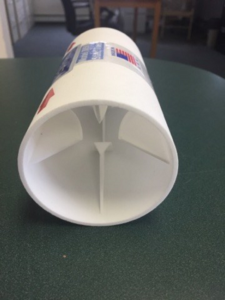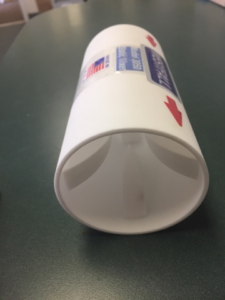 Usually when I think about mixers, I start dreaming about baking brownies and cakes for birthday parties and holidays. 3D printing technology has been used to make hand mixers, both electric and manual. In 2016, a handheld Thor3D Scanner and a ceramic composite mold were used to help a large bakery, which operates several professional-grade dough mixers, come up with a less time-consuming and costly way to replace the spiral screw that actually mixes the dough.
Usually when I think about mixers, I start dreaming about baking brownies and cakes for birthday parties and holidays. 3D printing technology has been used to make hand mixers, both electric and manual. In 2016, a handheld Thor3D Scanner and a ceramic composite mold were used to help a large bakery, which operates several professional-grade dough mixers, come up with a less time-consuming and costly way to replace the spiral screw that actually mixes the dough.
But there are other types of mixers out there – cement mixers, for one, and 3D printing technology was also used to create a unique mixer that can mix together multiple materials in zero gravity conditions.
 Located near the Port of Providence, Rhode Island, Westfall Manufacturing specializes in high-performance drop-in motionless (static) mixers, which are used in pipeline and blending systems for multiple industries, such as aerospace, water and wastewater treatment, oil, gas and biofuels, chemical, food and beverage, and insulation.
Located near the Port of Providence, Rhode Island, Westfall Manufacturing specializes in high-performance drop-in motionless (static) mixers, which are used in pipeline and blending systems for multiple industries, such as aerospace, water and wastewater treatment, oil, gas and biofuels, chemical, food and beverage, and insulation.
Each of the company’s many static mixers, which provide energy-efficient, high performance mixing for decades, is designed and custom manufactured to solve a specific customer problem, such as retrofits and infrastructure upgrades. Westfall specializes in oversize mixers, but as the company recently added 3D printing technology to its workflow, it can now fabricate smaller static mixers.
 The company had been receiving requests from customers, asking for its patented Low Headloss Mixer 3050 in a smaller size, specifically in the 3/8″ to 5″ range – far too small to cost-effectively fabricate using custom stainless steel or fiberglass.
The company had been receiving requests from customers, asking for its patented Low Headloss Mixer 3050 in a smaller size, specifically in the 3/8″ to 5″ range – far too small to cost-effectively fabricate using custom stainless steel or fiberglass.
The company has patented mixing vanes, and four of these tapered and curved vanes are welded around the interior of the mixer’s pipe. Each vane is angled 45° to resist fouling, which gives the Low Headloss Mixer 3050 series the ability to provide precise mixing, with two to four times less headloss than other static mixers provide and no maintenance.
While trying to figure out how to make the mixer smaller, engineers at Westfall knew that the material choice didn’t matter as much as the geometry – so long as the hydrodynamics stayed the same, fiberglass, metal, or even 3D printed nylon could be used. So the company decided to apply 3D printing technology to the manufacturing process for its Low Headloss Mixer 3050.
Engineers manufactured a smaller version of the mixer by 3D printing vanes and inserts out of durable nylon material, which were then attached to the inside of a PVC pipe with glue.
The 3D printed inserts can be made from multiple materials, such as stainless steel and Kynar, but the durable nylon used in this smaller, pre-assembled Static Mixer is able to hold up better under steady exposure to harsh chemicals like oil, gas, and caustics.
“For mixing low velocity, low viscosity water and gases, durable 3D printed nylon inserts are the wave of the future. For mixing high velocity and high viscosity fluids, durable 3D printed stainless steel inserts are the wave of the future,” said Westfall CEO Bob Glanville. “Either way, 3D printing makes our high performance Static Mixers more affordable to customers around the world.”
By using 3D printing technology to make the mixer in a smaller size, Westfall’s many customers can save on both time and money.
Let us know your thoughts; join the discussion of this and other 3D printing topics at 3DPrintBoard.com or share your thoughts in the Facebook comments below.
[Sources: Westfall, PR Newswire / Images: Westfall]
Subscribe to Our Email Newsletter
Stay up-to-date on all the latest news from the 3D printing industry and receive information and offers from third party vendors.
You May Also Like
World’s Largest Polymer 3D Printer Unveiled by UMaine: Houses, Tools, Boats to Come
The University of Maine has once again broken its own record by unveiling the largest polymer 3D printer in the world. Surpassing its 2019 achievement, the new Factory of the...
Changing the Landscape: 1Print Co-Founder Adam Friedman on His Unique Approach to 3D Printed Construction
Additive construction (AC) is much more versatile than it seems, at first: as natural as it is to focus on the exciting prospect of automated home construction, there’s far more...
Gorilla Sports GE’s First 3D Printed Titanium Cast
How do you help a gorilla with a broken arm? Sounds like the start of a bad joke a zookeeper might tell, but it’s an actual dilemma recently faced by...
3D Printing Webinar and Event Roundup: April 21, 2024
It’s another busy week of webinars and events, starting with Hannover Messe in Germany and continuing with Metalcasting Congress, Chinaplas, TechBlick’s Innovation Festival, and more. Stratasys continues its advanced training...































